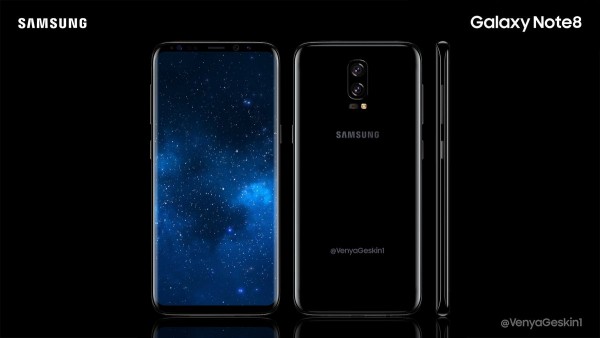It looks like smartphone buyers will need to start shelling out in excess of a thousand dollars for a premium device from 2017 onwards. On the heels of iPhone 8 rumors about pricing starting at $1,000, it is now reported that the Samsung Galaxy Note 8 will retail from September starting at €999, or roughly $1,120.
This new information came via VentureBeat. The source also revealed that the Note 8 will have a 6.3-inch AMOLED edge-to-edge display that comes on the Samsung Galaxy S8 and S8+, and will be launched in the second half of September 2017.
Under the hood of the Note 8 will be the same Exynos 8895 / Snapdragon 835 combination depending on the market, but it will have a more hefty 6GB of RAM. It will also sport dual cameras on the rear side, a first for Samsung and in line with the trend that’s being set with 2017 premium smartphones.
Unfortunately, the fingerprint sensor will be in the same position, but with more spacing between it and the horizontally aligned camera lenses. On the battery front, Samsung is toning it down to a very modest 3300mAh, which might be a fallout decision from the Note 8 fiasco from last year.
On the Note 8, users will be able to pin S Pen handwritten notes to the AOD, or Always On Display. We’ll also see DeX on the Note 8, and the source says that it can be used with the same dock as the Samsung Galaxy S8.
The pricing, however, is what’s alarming, because it can easily set a trend for premium smartphone makers moving forward.
The issue here is that smartphone manufacturers are hard-pressed to find and add innovative features to their devices, and the components required to support those features are fairly expensive.
But rather than follow the general trend of components getting cheaper over time, because new components are always being sought, it’s suddenly become what’s called a seller’s market. That’s where the seller dictates pricing rather than the buyer. Companies like Apple and Samsung do have some muscle to negotiate lower pricing, but with limited component suppliers, that doesn’t go a long way.
Don’t be surprised if most premium devices next year follow the same thousand-dollar trend. It looks like that’s the only way smartphone companies are going to make any money.
Thanks for visiting! Would you do us a favor? If you think it’s worth a few seconds, please like our Facebook page and follow us on Twitter. It would mean a lot to us. Thank you.



